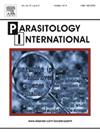Prevalence, risk factors, diagnosis and outcomes of Toxoplasma gondii infection in pregnancy: A review
IF 1.9
4区 医学
Q3 PARASITOLOGY
引用次数: 0
Abstract
Background
Toxoplasmosis, caused by the zoonotic protozoan Toxoplasma gondii, poses substantial risks during pregnancy, including adverse maternal and neonatal outcomes.
Objective
This review synthesized global evidence on the prevalence, risk factors, diagnostic methods, and clinical consequences of T. gondii infection in pregnant populations.
Methods
Adhering to PRISMA 2020 guidelines, a literature search of Medline/PubMed and ScienceDirect/Scopus databases (up to February 14, 2025), employed Medical Subject Headings (MeSH) and keywords such as “Toxoplasma gondii,” “pregnancy,” “congenital toxoplasmosis,” and “seroprevalence.” Eligible studies underwent rigorous screening, yielding 18 articles representing diverse regions in Africa, Asia, Latin America, Europe, and North America.
Results
Seroprevalence rates varied significantly, from 4.2 % in Mexican cohorts to 71 % in parts of Brazil. Key risk factors included contact with cats, raw/undercooked meat consumption, soil exposure, inadequate hygiene, and unpasteurized milk consumption. Diagnosis primarily relied on serological assays (IgG/IgM ELISA), augmented by molecular techniques (PCR) and IgG avidity testing to identify acute infections. Adverse outcomes such as miscarriage, preterm labour, and congenital toxoplasmosis were consistently reported, though the implications of latent infection remained unclear.
Conclusion
These findings underscore toxoplasmosis as a critical public health challenge in pregnancy, necessitating enhanced prenatal screening, refined diagnostic protocols, and targeted education to reduce exposure risks. Longitudinal studies are urged to clarify the effects of latent infection and guide evidence-based interventions globally.
妊娠期刚地弓形虫感染的流行、危险因素、诊断和结局综述
弓形虫病是由人畜共患病的原生动物刚地弓形虫引起的,在怀孕期间会造成重大风险,包括不良的孕产妇和新生儿结局。目的对妊娠人群中弓形虫感染的流行、危险因素、诊断方法和临床后果进行综述。方法根据PRISMA 2020指南,检索Medline/PubMed和ScienceDirect/Scopus数据库(截至2025年2月14日)的文献,采用医学主题标题(MeSH)和关键词,如“弓形虫”、“妊娠”、“先天性弓形虫病”和“血清患病率”。符合条件的研究经过严格筛选,产生了18篇文章,代表了非洲、亚洲、拉丁美洲、欧洲和北美的不同地区。结果血清患病率差异很大,从墨西哥人群的4.2%到巴西部分地区的71%。主要风险因素包括与猫接触、食用生/未煮熟的肉类、接触土壤、卫生条件差和食用未经巴氏消毒的牛奶。诊断主要依靠血清学检测(IgG/IgM酶联免疫吸附试验),辅以分子技术(PCR)和IgG亲和力检测来确定急性感染。尽管潜伏性感染的影响尚不清楚,但诸如流产、早产和先天性弓形虫病等不良后果的报道一直存在。结论:弓形虫病是妊娠期重大的公共卫生挑战,需要加强产前筛查、完善诊断方案和有针对性的教育,以降低暴露风险。人们迫切需要进行纵向研究,以阐明潜伏感染的影响,并在全球范围内指导循证干预措施。
本文章由计算机程序翻译,如有差异,请以英文原文为准。
求助全文
约1分钟内获得全文
求助全文
来源期刊

Parasitology International
医学-寄生虫学
CiteScore
4.00
自引率
10.50%
发文量
140
审稿时长
61 days
期刊介绍:
Parasitology International provides a medium for rapid, carefully reviewed publications in the field of human and animal parasitology. Original papers, rapid communications, and original case reports from all geographical areas and covering all parasitological disciplines, including structure, immunology, cell biology, biochemistry, molecular biology, and systematics, may be submitted. Reviews on recent developments are invited regularly, but suggestions in this respect are welcome. Letters to the Editor commenting on any aspect of the Journal are also welcome.
 求助内容:
求助内容: 应助结果提醒方式:
应助结果提醒方式:


